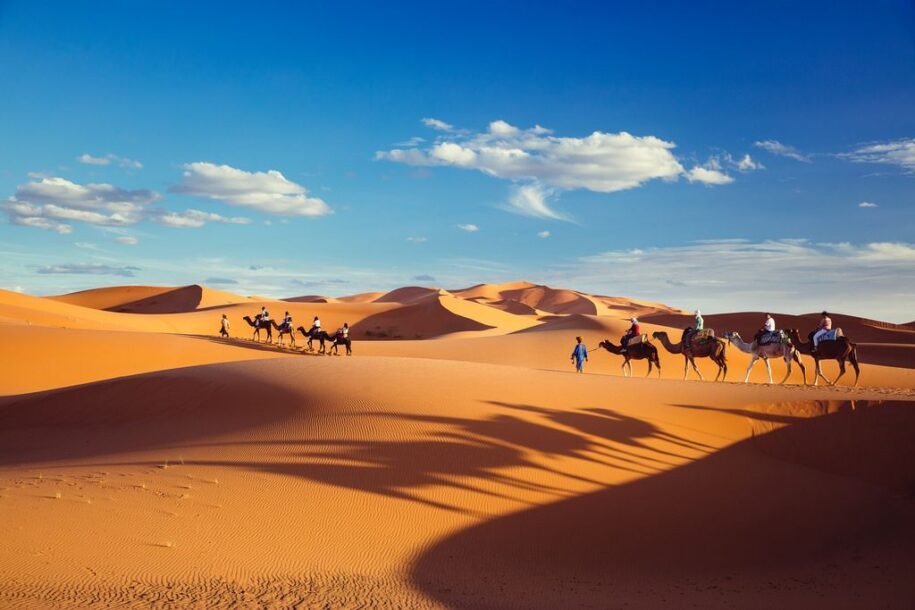The Sahara Desert is one of the most extreme places on Earth, known for its vast golden dunes, dramatic landscapes, and challenging climate. Understanding the weather in this iconic desert is essential for anyone planning a visit, whether for adventure, exploration, or simply to experience its breathtaking beauty. This guide offers detailed insights into the Sahara’s climate, breaking it down by season, month, and specific recommendations.
Overview of the Sahara’s Weather
The Sahara is characterized by very low rainfall, hot days, and cool nights. The most noticeable differences occur during the summer months when the temperatures soar, and the contrast between daytime and nighttime temperatures becomes extreme. In winter, while daytime temperatures are milder, the nights can be very cold. The desert’s climate is unpredictable, making preparation a key aspect of any journey.
Weather in the Sahara by Season
Spring (March to May)
Spring in the Sahara brings moderate warmth during the day and cooler temperatures at night. This season is considered one of the best times to visit, as the desert’s climate is less harsh compared to summer. By May, the temperatures begin to rise, and the sun becomes stronger, making it essential to carry sunscreen, hats, and lightweight, breathable clothing.
For travelers, spring is ideal for exploring the vast dunes of Merzouga or taking a camel trek in Erg Chebbi, as the weather is comfortable enough to enjoy outdoor activities during the day.
Summer (June to August)
The Sahara experiences its hottest temperatures during summer, often exceeding 40°C (104°F) in the daytime. In July, temperatures can peak at 43°C (109°F) or higher. Nights are cooler but still warm compared to other seasons. This is not the most popular time to visit, as the heat can be overwhelming, especially for activities that involve prolonged exposure to the sun.
For those who do choose to visit during summer, it is vital to take breaks during the hottest part of the day, stay hydrated, and wear loose, long-sleeved clothing to protect against the sun.
Autumn (September to November)
Autumn marks the return of milder conditions in the Sahara. The temperatures begin to drop in September, making the desert more welcoming for visitors. By November, the daytime heat becomes pleasant, and the nights are comfortably cool. This season is another great time to explore the Sahara’s landscapes, as the weather allows for longer outdoor activities, such as sandboarding or quad biking.
The stunning sunsets and starry nights of the Sahara are particularly enjoyable during autumn, making it a magical time to visit.
Winter (December to February)
Winter in the Sahara brings the coldest temperatures, especially at night. During the day, the temperatures are pleasant, averaging 18°C (64°F) in January, but at night, they can drop to as low as 3°C (37°F) or even lower in some areas. This makes warm clothing essential for overnight stays in the desert.
Despite the chilly nights, winter is a fantastic time to visit, as the clear skies and mild days create a perfect environment for exploring. Activities like stargazing and enjoying a traditional Berber campfire are highlights during this season.
Month-by-Month Weather in the Sahara
January and February
The coldest months of the year, with average temperatures ranging from 18°C (64°F) during the day to 3-6°C (37-43°F) at night. Warm clothing is a must.
March and April
Temperatures begin to rise, with daytime highs reaching 24-29°C (75-84°F) and cooler nights at 9-13°C (48-55°F). Ideal for outdoor activities.
May and June
The transition to summer brings hotter days. In May, temperatures climb to 34°C (93°F), and by June, they reach 38°C (100°F). Nights remain warm.
July and August
These are the hottest months, with temperatures often exceeding 43°C (109°F) during the day. Nights are cooler, averaging 25-26°C (77-79°F).
September and October
Temperatures start to decline, with daytime highs of 34-30°C (93-86°F). Nights become cooler, averaging 15-19°C (59-66°F).
November and December
Cooler weather returns, with daytime temperatures ranging from 22-18°C (72-64°F) and colder nights averaging 5-9°C (41-48°F).
Sahara Weather for the Next Few Days
For real-time weather updates, travelers can check local forecasts for specific regions such as Merzouga or M’Hamid, two popular gateways to the desert. Typically, these forecasts provide temperature ranges, wind speeds, and advice on whether to prepare for potential sandstorms.
Recommendations for Travelers
Visiting the Sahara Desert requires proper preparation to handle its extreme conditions. Here are some key tips:
- Protect Yourself from the Sun
Always carry sunglasses, sunscreen, and a wide-brimmed hat to shield yourself from the intense sunlight. Lightweight, breathable clothing made of cotton or linen is ideal. - Stay Hydrated
Bring plenty of water to stay hydrated, especially if you’re visiting during the hot summer months. - Pack for Cool Nights
Even in summer, desert nights can be significantly cooler than the days. In winter, pack warm clothing, including a jacket, hat, and gloves. - Choose the Right Footwear
Sturdy, ankle-covering shoes are essential for walking on uneven sand dunes. Sandals are suitable for casual wear around camps. - Prepare for Sandstorms
Carry a scarf or bandana to cover your face in case of a sudden sandstorm. These are rare but can occur, especially in the windy seasons. - Use a Sleeping Bag in Winter
If you’re camping overnight, a warm sleeping bag is highly recommended to ensure comfort during the cold desert nights.
Why Visit the Sahara?
The Sahara is more than just a desert; it’s an experience of a lifetime. From the stunning golden dunes of Erg Chebbi to the remote landscapes of Erg Chigaga, the Sahara offers unique activities such as camel trekking, quad biking, and stargazing. The serene silence of the desert, combined with its breathtaking beauty, creates memories that will last forever.
Conclusion: Sahara desert temperature
Understanding the weather in the Sahara Desert is crucial for making the most of your visit. Whether you’re planning to explore in the mild temperatures of spring or the cooler days of winter, preparation is key. With the right gear and timing, your journey to this iconic desert will be safe, enjoyable, and unforgettable.


Leave a Reply